Overview
The article addresses the emotional challenges faced by healthcare providers, particularly the stress of managing extensive documentation. It highlights how using medical chart templates can alleviate these burdens, enhancing both efficiency and patient care. By improving documentation accuracy and reducing administrative tasks, healthcare professionals can focus more on what truly matters—their patients.
Imagine a work environment where team collaboration thrives, and every member feels supported. Medical chart templates foster this atmosphere, allowing for seamless communication and shared understanding among healthcare teams. This not only enhances the quality of care but also nurtures a compassionate healthcare environment.
As we explore the advantages of these templates, consider how they can transform your practice. The benefits are clear:
- Improved accuracy
- Reduced workload
- Enhanced collaboration
All contribute to a more effective healthcare experience. Embracing these tools can lead to a more fulfilling and impactful practice.
Take a moment to reflect on your current challenges. How could streamlined documentation improve your day-to-day interactions with patients? We encourage you to explore the possibilities that medical chart templates offer. Together, we can create a healthcare landscape that prioritizes compassion and excellence.
Introduction
In the fast-paced world of healthcare, where every second counts, the weight of administrative tasks can often overshadow the vital mission of patient care. Have you felt this burden? Medical chart templates offer a transformative solution, aiming to streamline documentation and enhance efficiency for dedicated healthcare providers like you. But how can these templates not only ease your stress but also promote higher accuracy, better compliance, and ultimately, improved patient outcomes?
As the healthcare landscape evolves, it becomes increasingly important to integrate structured and standardized charting methods. This approach fosters a more compassionate and effective care environment. Imagine a world where you can focus more on your patients and less on paperwork. Together, let’s explore how embracing these innovative solutions can lead to a brighter future for both providers and patients alike.
CosmaNeura: Streamline Administrative Tasks with AI Medical Chart Templates
In today's healthcare environment, many professionals face overwhelming administrative duties that can detract from their ability to provide compassionate care. CosmaNeura's AI medical chart template provides a transformative solution, enabling medical professionals to reclaim valuable time for their patients. By leveraging advanced AI technology, the medical chart template independently manages client intake, triage, and documentation, significantly reducing the hours spent on routine tasks.
This shift not only enhances operational efficiency but also aligns with the , enabling providers to focus on what truly matters: delivering compassionate care without the burden of excessive administrative responsibilities. Imagine a future where healthcare professionals can dedicate more time to their patients—this is within reach. In 2025, the integration of AI in healthcare is projected to significantly boost administrative efficiency, with the global telehealth market expected to surpass USD 175.5 billion.
Research indicates that AI-driven solutions can free up an average of 15 minutes per individual for clinicians, leading to improved job satisfaction and better patient outcomes. As Dr. Mozziyar Etemadi eloquently states, "With our high-speed data pipes and the Aivres NF5488M5-D with NVIDIA A100 Delta, we can quickly iterate and utilize the state-of-the-art in AI to assist those we care for."
Let us embrace this change together, creating a more compassionate and efficient healthcare environment for all.

Enhance Accuracy in Patient Records with Standardized Templates
Standardized medical chart formats can significantly alleviate the emotional strain faced by healthcare providers. By creating a consistent recording structure, these formats not only improve the precision of patient records but also minimize the risk of errors commonly associated with free-text entries. This structured approach ensures that all essential information is systematically captured, allowing providers to focus more on patient care.
Consider the profound impact of these changes: studies have shown that the use of standardized forms led to a remarkable increase in the thoroughness of documentation. The percentage of fully completed overall examinations surged from 3.6% to 85.0%. Furthermore, the odds ratio for complete sensory examination in the sample group was an impressive 23.9. Such enhancements are crucial for informed clinical decision-making, leading to effective treatment strategies and ultimately improved outcomes for individuals.
Moreover, adherence to guidelines improved significantly, rising from 31.1% to 84.9% after the introduction of organized formats. This highlights the of these tools. Healthcare providers have shared that these forms facilitate more thorough inquiries regarding individuals, with around 90% of interactions including questions about psychiatric issues. By utilizing uniform formats, providers can simplify their documentation methods and enhance the overall quality of care given to individuals.
Key benefits of standardized medical chart formats include:
- Improved accuracy in patient records
- Increased thoroughness in documentation
- Enhanced adherence to clinical guidelines
- More comprehensive patient inquiries
By embracing these organized formats, healthcare providers can not only alleviate administrative burdens but also foster a more compassionate and effective care environment for their patients. How might these changes positively impact your practice and the lives of those you serve?
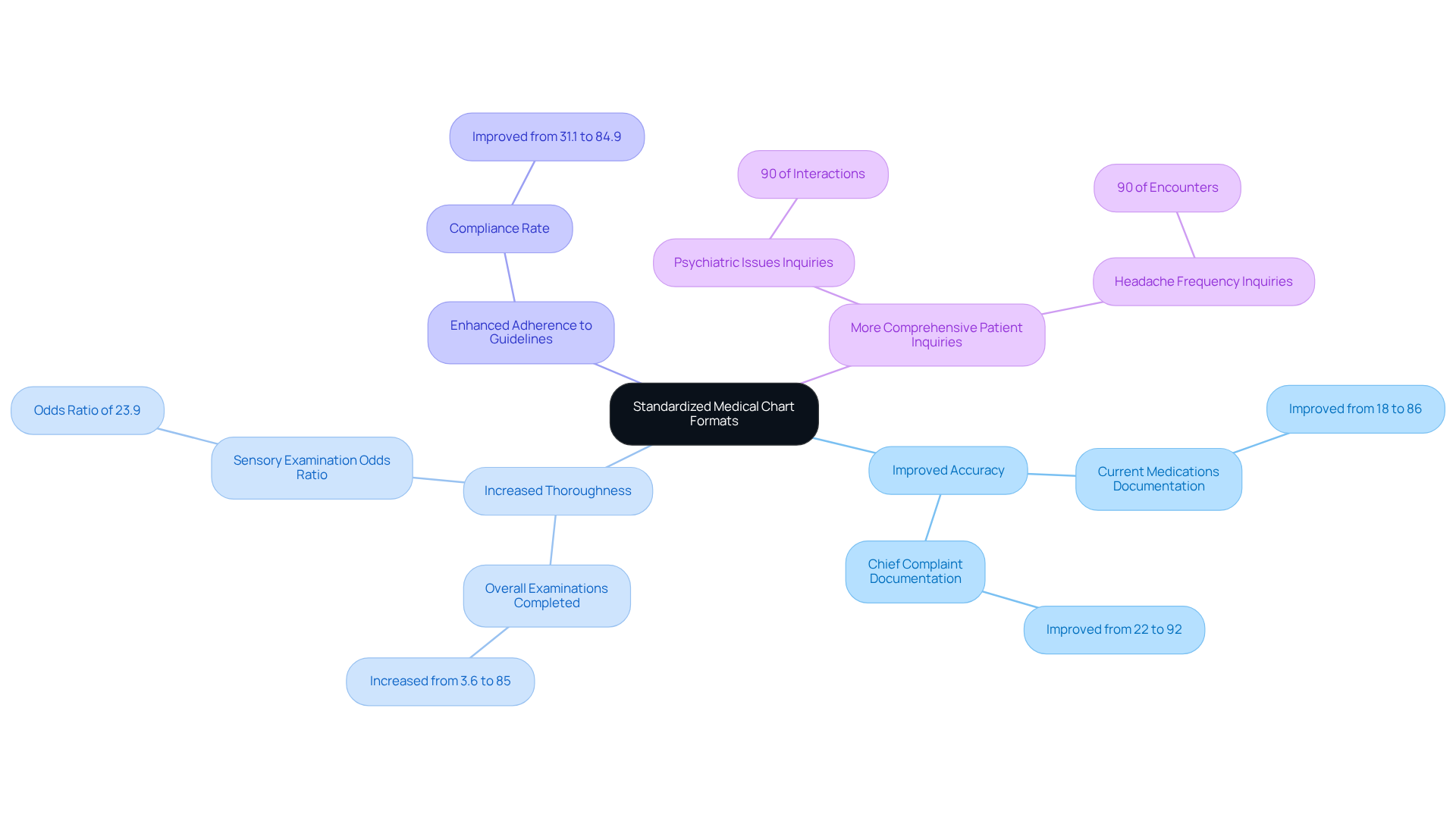
Improve Patient Care Quality by Utilizing Comprehensive Medical Charts
Comprehensive medical charts are essential for providing a holistic view of a patient's health history, treatments, and ongoing care. Have you ever considered how overwhelming it can be for healthcare providers to manage all this information? By utilizing a medical chart template, medical providers can ensure that all relevant information is documented, which is crucial for continuity of care. For instance, by 2017, nearly 86% of office-based physicians in the United States were using some form of EHR system. This statistic highlights the prevalence and importance of comprehensive medical charts in modern healthcare.
This comprehensive record enables providers to make informed choices and customize treatments to individual needs. Imagine the difference this can make in enhancing the quality of care provided. Healthcare professionals emphasize that comprehensive patient records not only improve treatment outcomes but also promote better communication among care teams. This results in more coordinated and effective patient management.
Employing organized formats allows providers to monitor changes over time, guaranteeing that essential health information is easily accessible and actionable. Furthermore, EHRs can streamline specific record-keeping tasks, improving efficiency and lessening the administrative load on medical providers. To implement effectively, medical professionals should consider adopting a medical chart template that facilitates detailed recording and promotes continuity of care. Together, we can ensure that every patient receives the attentive care they deserve.
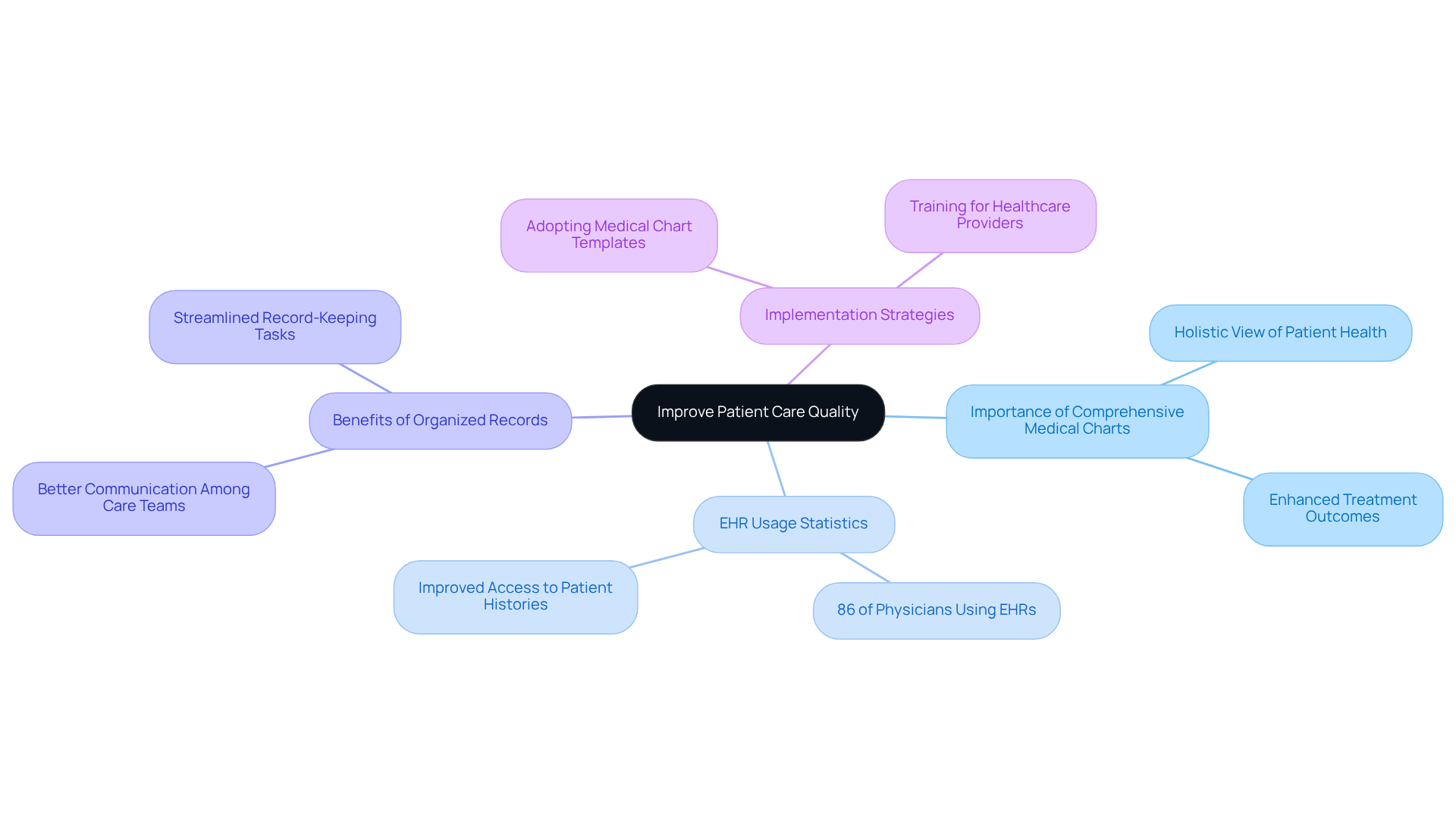
Save Time and Increase Efficiency with Pre-Designed Medical Chart Templates
Healthcare providers often face overwhelming emotional challenges due to administrative burdens. Using a can significantly alleviate this stress, enhancing efficiency by eliminating the need to create documentation from scratch. These formats streamline the charting process, enabling clinicians to quickly input patient information and redirect their focus to delivering quality care.
Research indicates that improving physician note formats can save an average of 2.6 hours each day. This was particularly evident in a quality improvement pilot study conducted in a Mother-Baby Unit, where enhanced note formats resulted in an average time savings of 23 minutes per infant. Imagine the relief of having more time to engage with each patient, fostering better relationships and care.
This increase in efficiency not only boosts job satisfaction—providers consistently find the new medical chart template easier to complete than previous note formats—but it also positively impacts patient outcomes. With more time available for direct interaction, clinicians can enhance the quality of care they provide. For instance, after implementing these frameworks, patient throughput improved, with the number of patients attended to per hour rising from 2.3 to 3.2.
Such advancements in record-keeping efficiency are crucial for improving patient throughput in clinics. By enabling medical providers to manage their time more effectively, these formats help maintain high standards of care. Furthermore, by reducing the administrative load associated with records, they can alleviate concerns about clinician fatigue.
Are you ready to explore how these solutions can transform your practice? Embracing a medical chart template may just be the key to enhancing both your well-being and that of your patients.
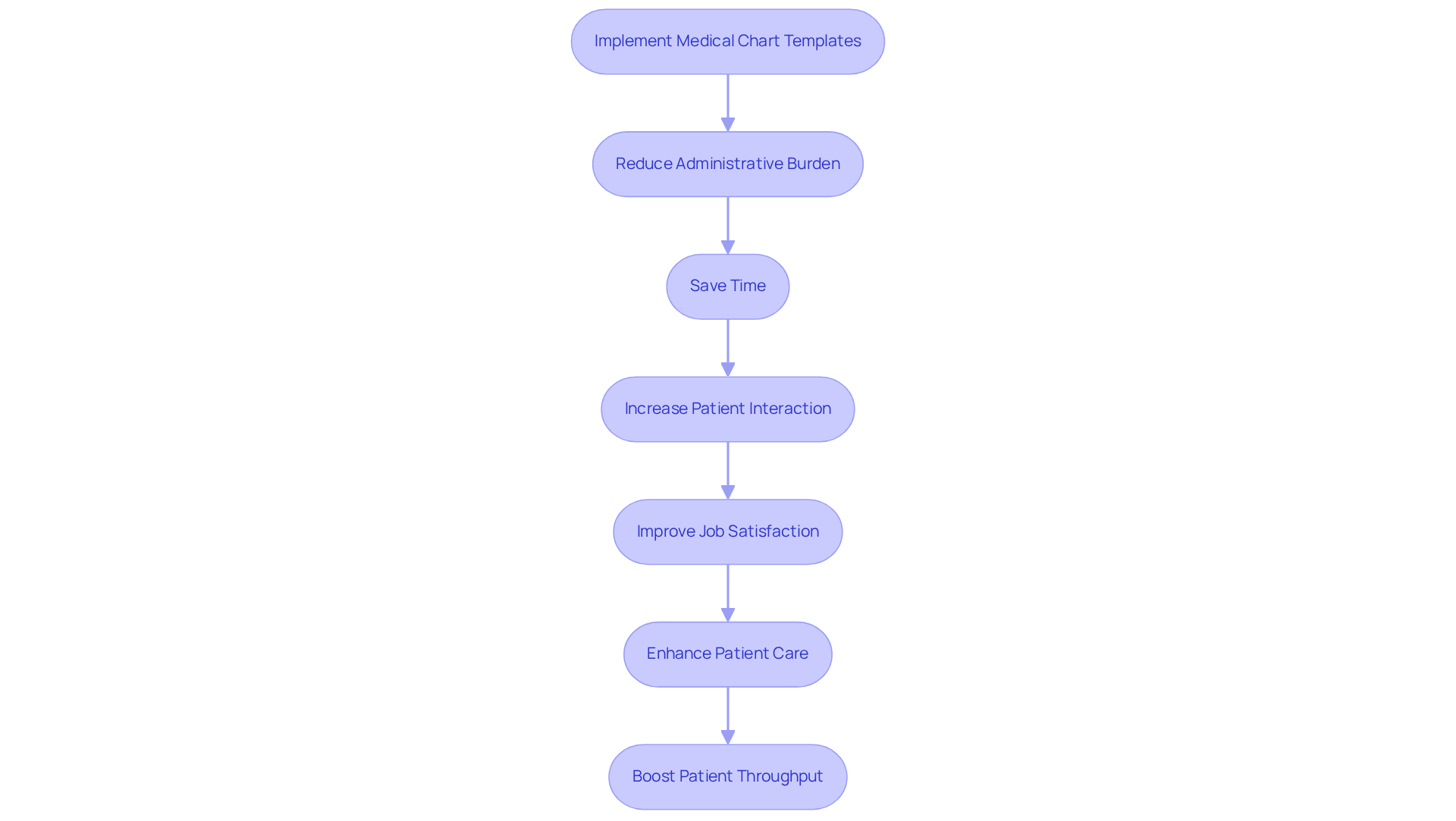
Ensure Compliance with Healthcare Regulations through Effective Charting
Utilizing a medical chart template is crucial for healthcare providers striving to meet , including HIPAA. The emotional burden of administrative tasks can weigh heavily on practitioners, making a systematic approach to record-keeping essential. This method significantly reduces the risk of mistakes and oversights that could lead to compliance issues, allowing providers to focus more on patient care.
By adopting the medical chart template, medical practitioners can not only shield their operations from potential legal repercussions but also enhance the overall quality of service provided to individuals. Research shows that organizations with robust compliance frameworks can reduce denial rates by as much as 30%, improving cash flow and operational efficiency. Have you considered how effective charting practices can alleviate stress during audits and investigations?
As medical specialist Lisa Knowles wisely notes, 'Precise record-keeping is a crucial connection between quality care for individuals and ensuring an organization’s finances are secure.' By prioritizing organized records, providers can foster adherence to best practices, nurturing a culture of compliance and excellence in patient care. Let's work together to create a supportive environment where both healthcare providers and patients thrive.
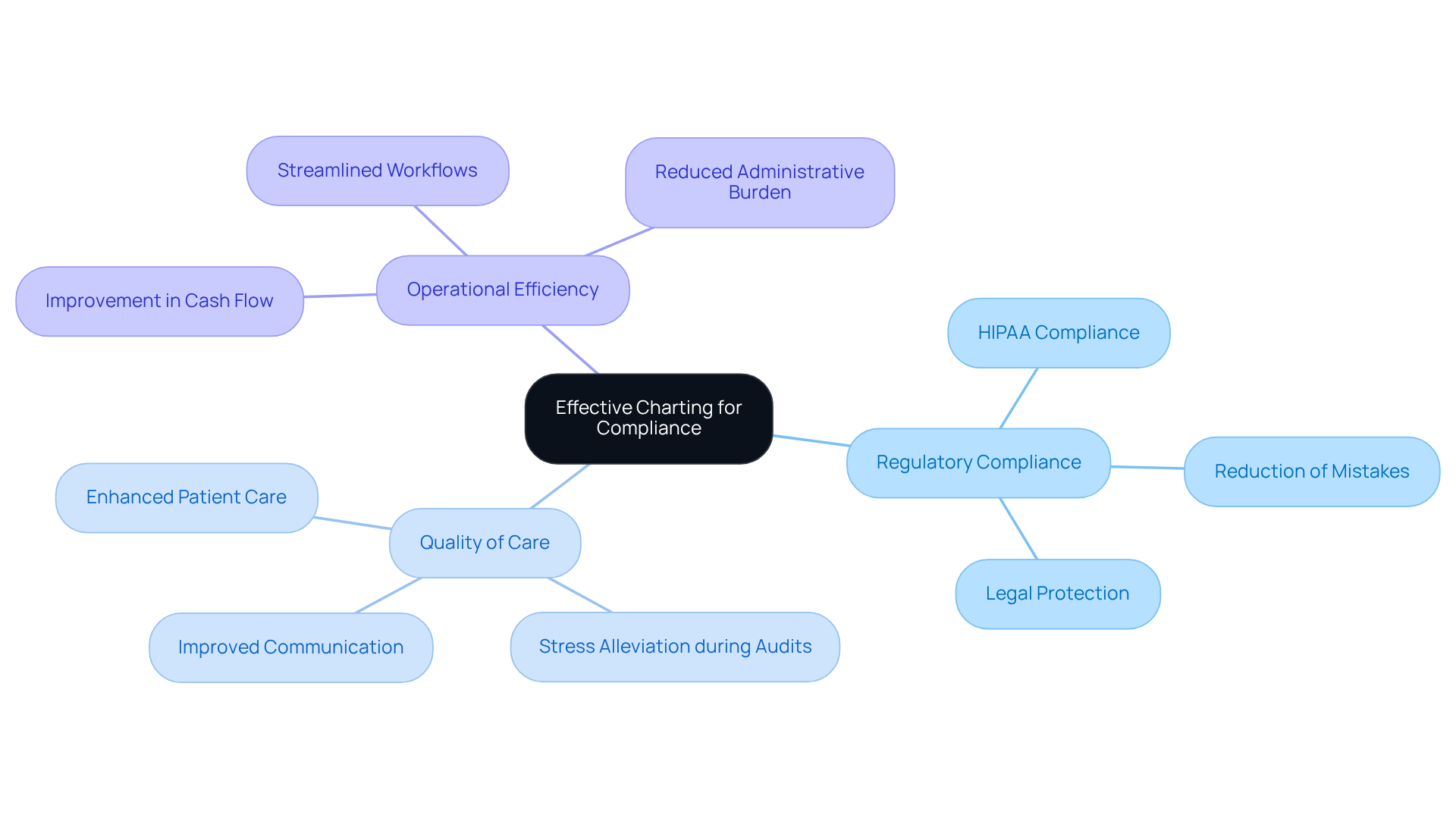
Facilitate Team Collaboration with Clear and Accessible Medical Charts
A medical chart template ensures that medical records are transparent and easily understandable, which can significantly enhance teamwork among medical groups by providing a consolidated view of individual information. Have you ever considered how vital it is for all team members to easily access and comprehend these materials? When this happens, communication and coordination of care improve dramatically. This collaborative approach ensures that everyone involved in a person's care is informed and aligned, leading to better outcomes and a more cohesive care experience.
Research indicates that effective communication can reduce conflict resolution time by 50%. This statistic underscores the importance of having to facilitate interactions among medical professionals. Moreover, organizations that prioritize collaboration enjoy a 50% lower employee turnover rate, showcasing the positive impact that a clear medical chart template has on team dynamics and job satisfaction.
By enhancing communication through a medical chart template, medical teams can coordinate care more effectively, ensuring all members contribute to a comprehensive treatment approach. To improve record-keeping methods, medical providers should consider adopting [AI-driven solutions](https://cosmaneura.com), such as those offered by CosmaNeura. These tools provide instant transcription and summarization for telehealth sessions, ensuring that client information is both precise and easily accessible.
Isn't it time we embraced these advancements to foster a more supportive healthcare environment?
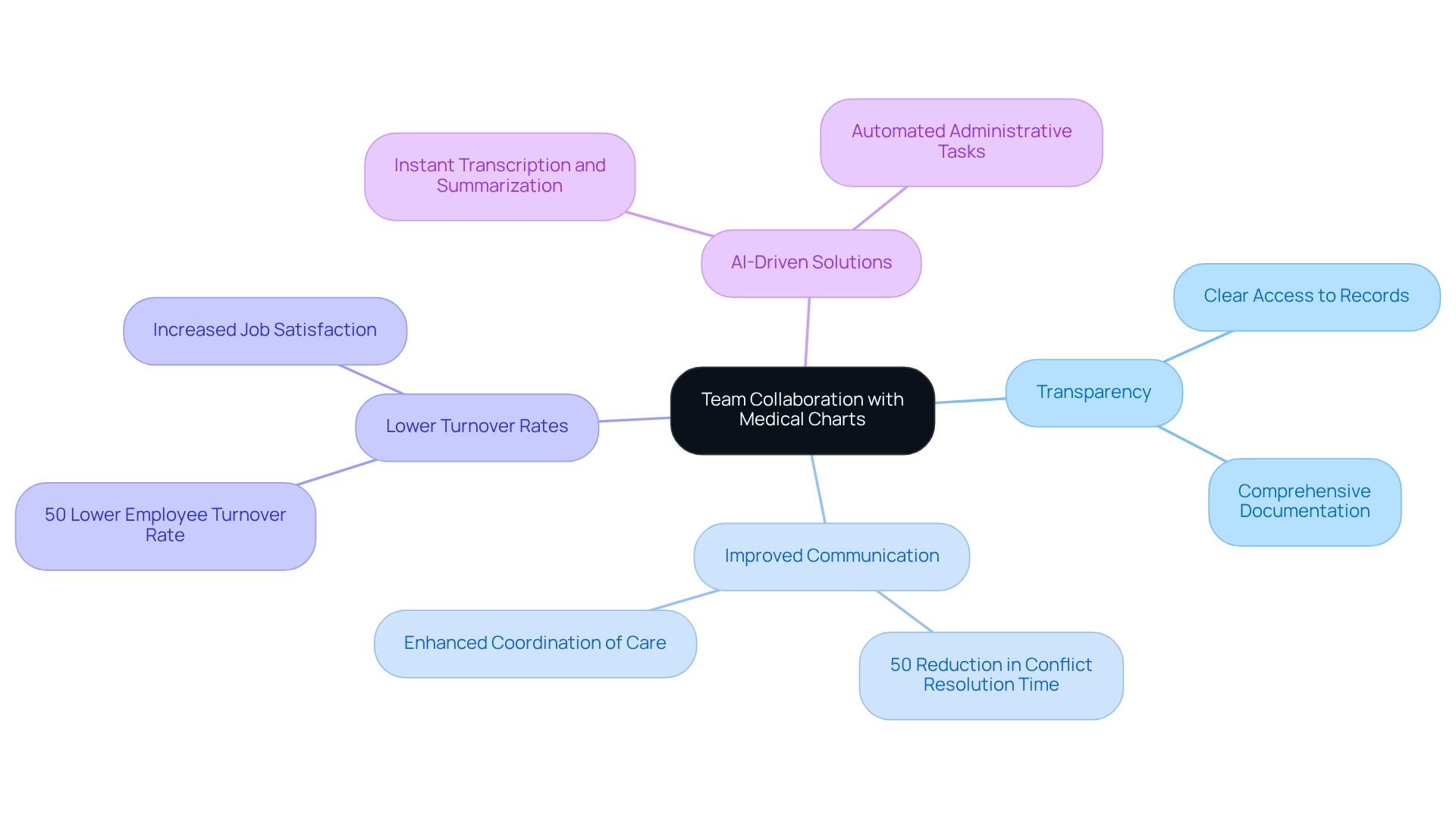
Adapt Medical Chart Templates to Fit Diverse Healthcare Environments
The unique needs of various medical settings, from primary care centers to specialized practices, can be addressed by tailoring medical chart templates. This adaptability empowers providers to adjust formats according to their workflows, patient demographics, and recording necessities. By customizing a medical chart template, healthcare providers can significantly improve operational efficiency, ensuring that all pertinent information is accurately documented regardless of the clinical environment.
For instance, have you considered how Cerner EMR offers customization tools that enable specialized record templates? These tools have been shown to enhance care coordination and reduce medication errors, ultimately leading to better patient outcomes. Furthermore, providers using customized charting solutions can reclaim multiple hours each day that were previously consumed by routine administrative tasks, as noted by CosmaNeura's platform. This approach not only streamlines documentation processes but also aligns with the growing emphasis on personalized care in today’s healthcare landscape.
As Riken Shah highlights, harnessing technological advancements is vital for ensuring medical services are both accessible and efficient. To begin , medical professionals should engage with end-users to gather insights on their specific needs and workflows.
Key Solutions to Consider:
- Tailored record formats to enhance efficiency.
- Tools that improve care coordination.
- Strategies to minimize administrative burdens.
By taking these steps, we can create a more compassionate and effective healthcare environment that truly addresses the needs of both providers and patients.
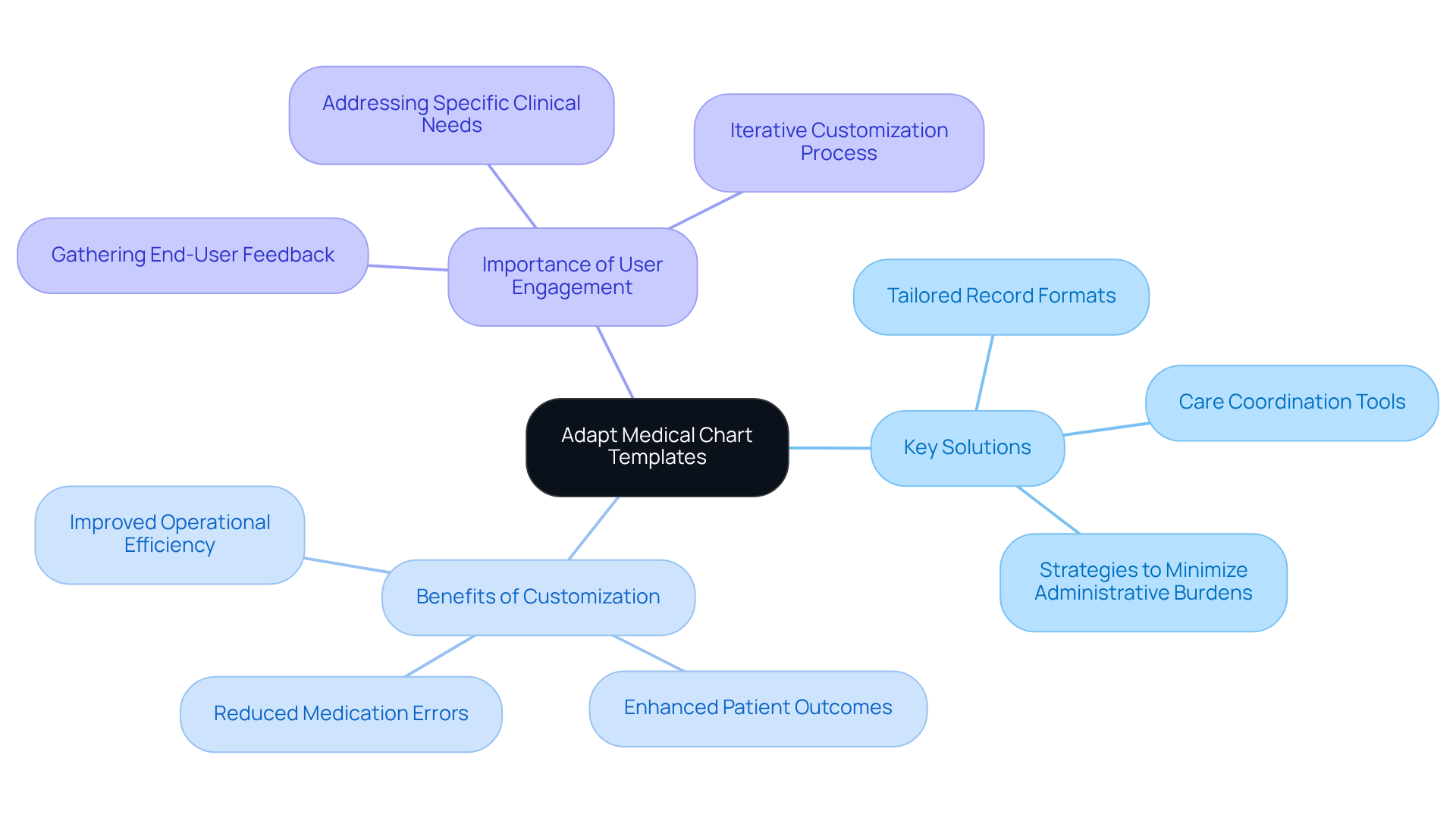
Reduce Documentation Errors with Structured Medical Chart Templates
Organized medical chart templates play a crucial role in alleviating the emotional burden associated with record-keeping errors that healthcare providers often encounter. By incorporating predefined fields and prompts for vital information, the medical chart template significantly minimizes the risk of omissions and inaccuracies that are typically linked to free-text entries. This structured methodology ensures that all necessary data is captured consistently, enhancing the .
Research indicates that organized records have elevated the grand mean score to 77.2, reflecting a remarkable 12.8-point increase (p < 0.001). This improvement directly correlates with enhanced safety for individuals receiving care, highlighting the profound impact that meticulous record-keeping can have on patient outcomes. Moreover, the absence of thorough records accounted for 32.52% of inadequate routine practice records, underscoring the critical need for organized formats.
The use of the medical chart template not only promotes precision but also fosters a culture of meticulousness in medical records, ultimately benefiting both providers and patients alike. As Colleen Harig insightfully remarked, "Providers facing unnecessary record errors experience serious repercussions for quality of care, individual safety, and staff satisfaction and productivity as a result."
Are you ready to embrace a more organized approach to record-keeping? By adopting these templates, you can contribute to a safer, more reliable healthcare environment for everyone involved.
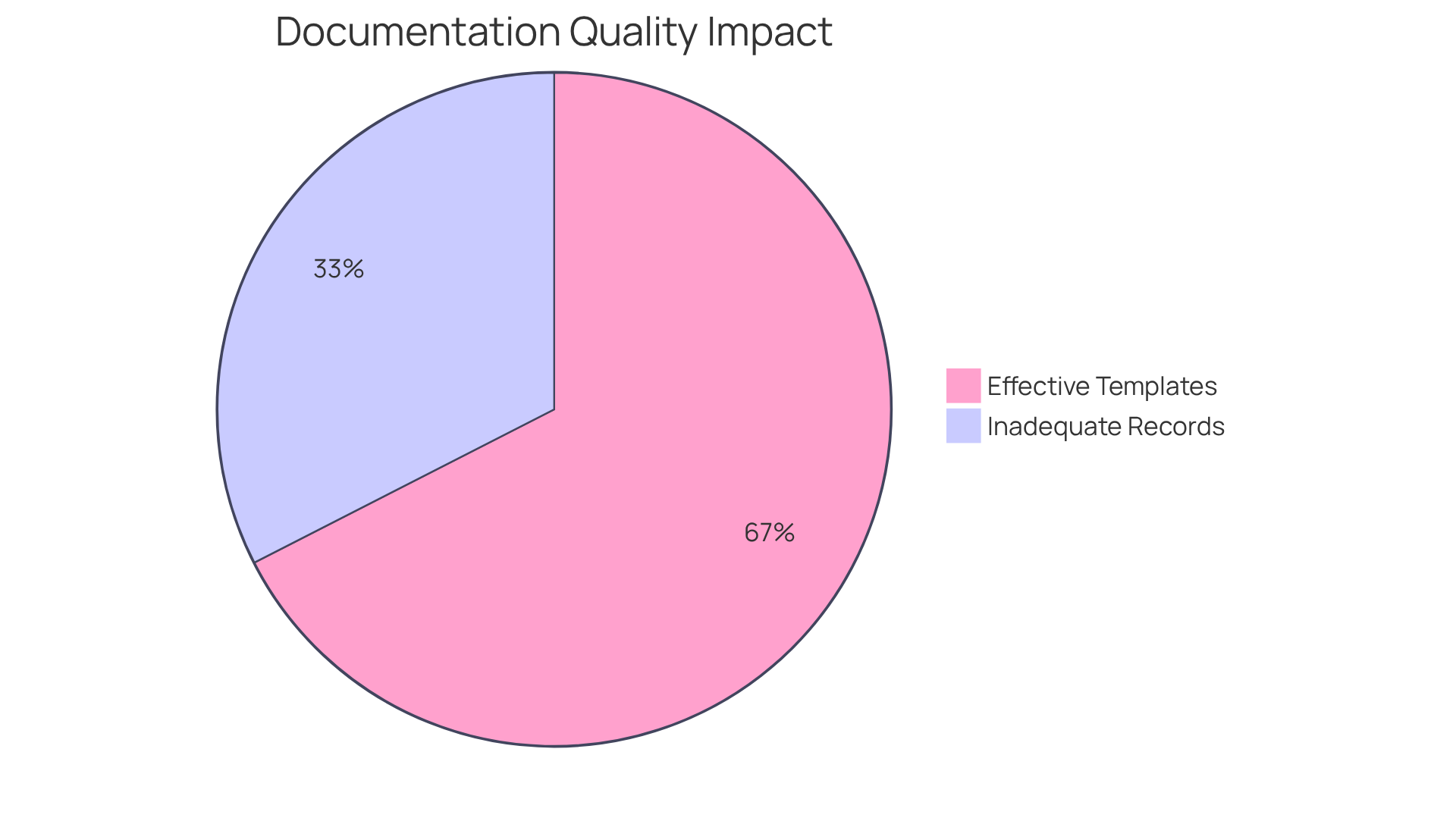
Enhance Billing Accuracy with Detailed Medical Chart Documentation
In the world of healthcare, detailed medical chart records are not just a requirement; they are essential for enhancing billing accuracy. These records provide a comprehensive account of patient encounters, diagnoses, and treatments. Have you ever felt overwhelmed by the administrative tasks that take away from patient care? By utilizing a medical chart template, medical providers can capture all relevant information, which is crucial for precise coding and billing. This thoughtful approach significantly reduces the risk of claim denials, addressing a common concern—studies show that account for approximately 75% of Medicare claim denials.
Moreover, structured charting streamlines the billing process and maximizes reimbursement potential. This contributes to the financial sustainability of healthcare practices, allowing clinics to reclaim several hours each day that were previously consumed by routine administrative tasks. Imagine the difference it could make if your team could focus more on patient care instead of paperwork. As noted, "Proper records are crucial for accurate medical billing."
By incorporating an organized medical chart template into medical record practices, healthcare providers can enhance billing precision and overall revenue cycle administration. This established approach not only supports your financial health but also nurtures the quality of care you provide to your patients. Let’s take this step together towards a more efficient and compassionate healthcare experience.
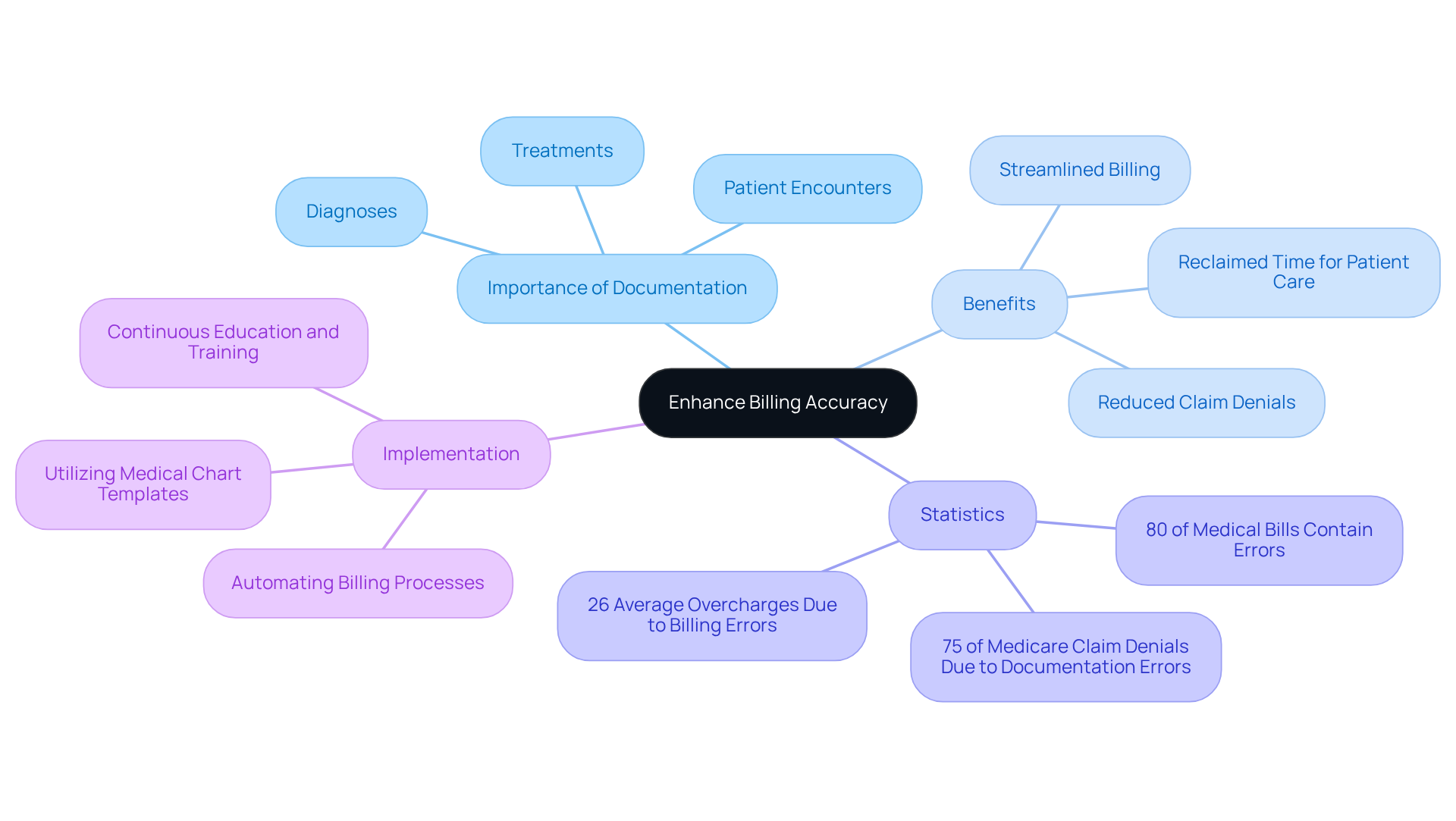
Achieve Long-Term Patient Satisfaction with Consistent Medical Charting
Dependable medical documentation is essential for fostering long-term client satisfaction, as it ensures that individuals receive coordinated and reliable care. Have you ever considered how much trust is built through clear documentation? By employing a medical chart template, medical providers can improve transparency and consistency in their documentation practices. This reliability promotes a sense of trust, making individuals feel valued and understood.
When medical providers maintain precise and orderly records, it not only enhances individual experiences but also leads to . For instance, research shows that the application of problem-focused frameworks (POTs) significantly enhances note quality, with scores increasing from 37.5 to 39.0 (P = 0.0020). This improvement supports effective communication and continuity of care.
Moreover, utilizing uniform formats can enhance interaction and involvement among medical providers and individuals, highlighting the importance of dependable records. Ultimately, consistent documentation practices empower providers to build stronger relationships with their patients, reinforcing trust and satisfaction in the medical experience.
To implement the medical chart template effectively, healthcare providers should consider integrating it into their electronic health record systems. This ensures ease of use and accessibility, allowing for a smoother workflow and better patient care. Let’s work together to create a more compassionate healthcare environment where everyone feels understood and cared for.
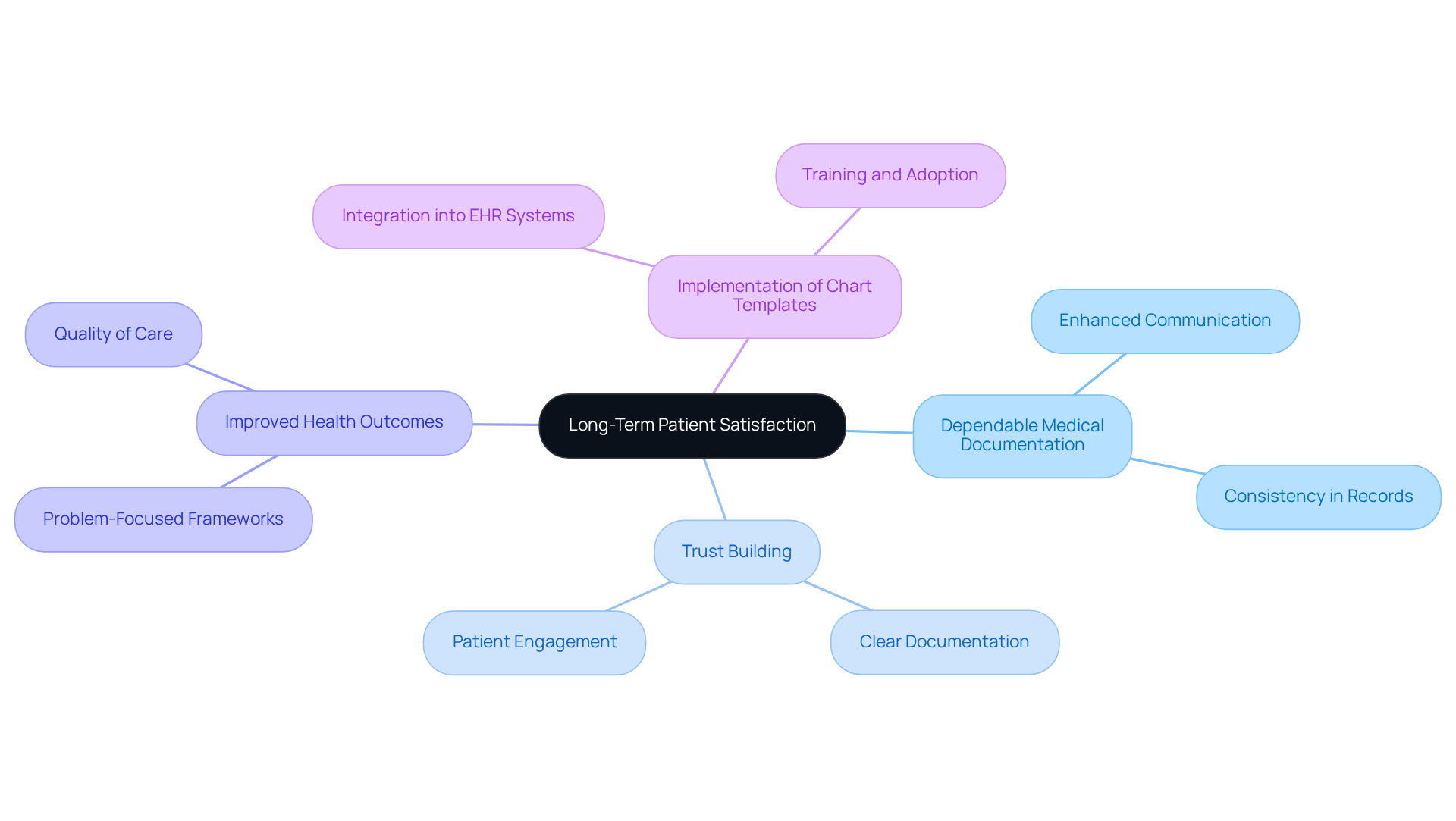
Conclusion
Implementing medical chart templates in healthcare marks a significant step forward in enhancing the efficiency and quality of patient care. Have you ever felt overwhelmed by administrative tasks? These templates streamline such duties, allowing healthcare providers to focus on delivering compassionate care instead of getting bogged down by paperwork. The integration of AI-driven solutions, like those offered by CosmaNeura, showcases how technology can transform healthcare environments, ensuring that professionals dedicate their time to what truly matters—their patients.
The key benefits of medical chart templates are numerous:
- They improve accuracy in patient records.
- They enhance documentation thoroughness.
- They increase compliance with healthcare regulations.
This structured approach not only reduces errors but also fosters better communication and collaboration among healthcare teams. By tailoring templates to fit diverse healthcare settings, providers can further optimize their workflows, ensuring that patient care remains a top priority.
As the healthcare landscape evolves, embracing these innovative solutions is essential for creating a more effective and compassionate environment. The potential for improved patient outcomes, increased job satisfaction for providers, and enhanced billing accuracy underscores the importance of adopting medical chart templates. By taking these steps, healthcare professionals can pave the way for a future where both patients and providers thrive, ultimately leading to a more satisfied and healthier community. Together, let’s take action towards this brighter future.




